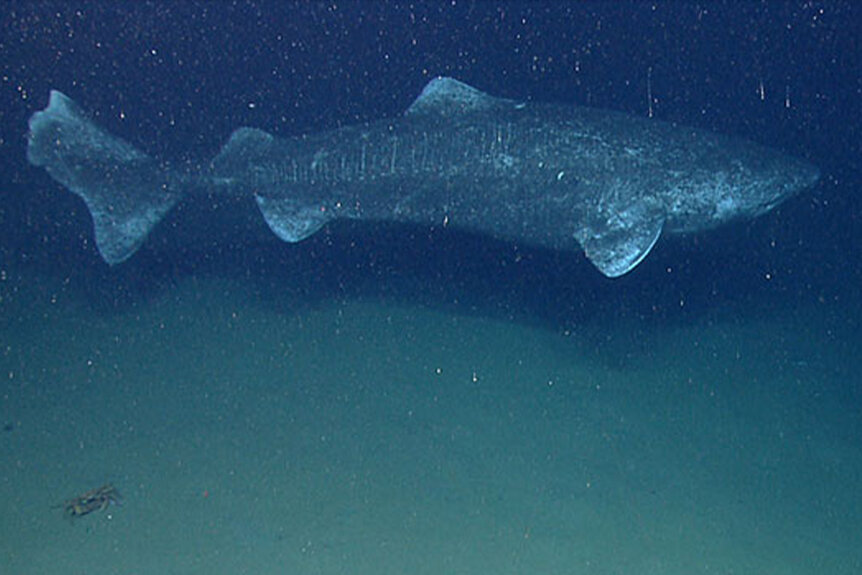Longest-Living Vertebrate Ever? Greenland Shark Thought to Be 393 Years Old, Give or Take a Century
The perfect organism. Its structural perfection is matched only by its lethargy.

In 1979, Ridley Scott taught us a truth so obvious in retrospect as to feel almost universal: in space, no one can hear you scream. That was the tagline for the science fiction classic Alien, streaming now on Peacock, which tells the story of Ripley (Sigourney Weaver) and the blue-collar spacefaring crew of the Nostromo, trapped on their ship with an extraterrestrial killing machine.
With the help of the infinitely twisted H.R. Giger, Scott and co. dreamt up the ultimate enemy, a creature so tuned for killing that it has mouths nested like Matryoshka dolls and blood made of acid. The android character, Ash (Ian Holm), described it like this, “You still don’t understand what you’re dealing with, do you? The perfect organism. Its structural perfection is matched only by its hostility … unclouded by conscience, remorse, or delusions or morality.”
There’s nothing quite so deadly perfect as Alien’s xenomorph here on Earth (thank Crom). Come to think of it, we’re not so sure that killing ability is the best measure of biological perfection, anyway. One could argue a better measure is longevity, the raw number of days you spend walking (or swimming, as the case may be) the Earth. By that admittedly biased yardstick, there is nothing more perfect than the Greenland shark, not by a nautical mile.
For More on Sharks:
A South African Killer Whale Took on a Great White Shark One-on-One and Won
Drone Footage Snaps Up the First Known Baby Photos of a Great White Shark (Probably)
Great White Sharks Have a Mysterious Second Life in the Ocean's Twilight Zone
Figuring Out How Old Greenland Sharks Actually Are
Greenland sharks (otherwise known as gurry sharks, gray sharks, or sleeper sharks) are cold water predatory fish that live in the North Atlantic and Arctic Ocean. For years, scientists have assumed they lived for centuries, but they couldn’t be sure. In other sharks, scientists can determine age by counting the growth rings in the vertebrae or fin spines, just like counting the rings in a tree trunk. Greenland sharks don’t have fin spines though, and their vertebrae are too squishy to leave a record of rings. They just don’t have any tissues hard enough for us to count the candles on their cake.
Without any direct way to measure, scientists had to estimate based on growth rates. They’d catch Greenland sharks, measure them, tag them, then release them. If the same shark got captured again later, they could measure it again and compare the new number to the old one. Using this process, researchers clocked an average growth rate of less than 1 centimeter per year. Considering that Greenland sharks can grow to more than 6 meters in length (that’s 600 centimeters for those of you keeping track), back of the napkin math puts a handful of centuries well within the realm of possibility.
Then, in 2016, scientists figured out a way to measure the age of Greenland sharks by radiocarbon dating tissues inside the sharks’ eyes. Before they are born, special proteins form in the center of a Greenland shark’s eyes, and they don’t degrade or disappear throughout their lives. These unchanging bits of material at the core of the eyeball act like a biological stopwatch that starts ticking when the shark is conceived and doesn’t stop.
Generally speaking, Greenland sharks aren’t intentionally captured (they were once hunted for their liver oil, but that practice has largely stopped) but they do get caught in fishing nets accidentally. Researchers used these accidental kills, known as bycatch, to dial in on the lifespan of the species by dating the proteins at the eyeball’s center. When the age estimates came back, the oldest of the 28 sampled sharks had an estimated age of 393 years, give or take a century.
With an expiration date somewhere in the range of 250 - 500 years, Greenland sharks are the longest-lived vertebrate species in the world. The longest-lived terrestrial (landlubbing) animal is a species of tortoise, the oldest of which is only 191 years old. His name is Jonathan. The only animals who live longer than the Greenland shark are all shaped like worms or made of jelly.
What Do Greenland Sharks Do for 400 Years?
It’s possible that their cold-water lifestyle is responsible for their long lives. Low temperatures tend to result in slower metabolisms and, at least in this case, longevity like you’ve never seen. Everything we know about these guys is slow. While very little is known about their reproductive practices or processes, scientists believe their gestation period is somewhere between 8 and 18 years – by the time a Greenland Shark finally finishes painting the nursery we’re sending our kids off to college – and they don’t reach maturity until they are roughly 150 years old.
With such a long gestation period, they keep their eggs inside their bodies and give birth to live pups, up to 10 at a time. There are Greenland sharks alive today who were alive when the Wright brothers made their historic first flight, and those sharks haven’t even started thinking about dating yet. And those sharks could have parents or grandparents still swimming the Arctic waters who were alive when Newton published Principia (1687) or when Galileo first peeped Jupiter (1610).
There’s a lot about Greenland sharks we still don’t know, in large part because we don’t come across them very often. They prefer cold, deep waters, swimming more than 2,000 meters beneath the northern seas, immersed in temperatures between 28 and 47 degrees Fahrenheit. They aren’t the sorts of places tourists tend to gather for spring break, but the Greenland shark calls them home, thanks to a sort of naturally occurring antifreeze in their cells which prevents ice crystals from forming as they move gently through frigid waters at a sluggish 3 kilometers per hour.
These slow-moving arctic drifters are mostly scavengers, picking up whatever prey they can get hold of and whatever carrion they can find. They’ve even been documented chowing down on terrestrial animals like deer who were unfortunate enough to fall through the ice. They might also be opportunistic hunters, using stealth (or just fortuitous laziness) to coax unsuspecting prey into their slow-moving jaws. From assessing their victims, we know that they latch onto prey with their top teeth and roll their head, using the bottom teeth to remove pieces of flesh like a can opener removing a tin lid.
That horrifying image aside, they aren’t a threat to humans. At least, not a frequent one. There is only one recorded incidence of a Greenland shark attack on a human being. A report from 1859 describes a captured Greenland shark with a human leg in its stomach. Since then, we’ve maintained a sort of tenuous peace. They aren’t of much commercial fishing interest now that their liver oil has fallen out of favor, mostly because their meat can make you sick.
Unless the proper steps are taken, the meat is toxic to both humans and dogs, due to an overabundance of trimethylamine oxide, leading to trimethylamine (TMA) poisoning. A 1991 study in the journal Toxican found that consumption of untreated meat leads to intestinal distress and symptoms similar to those experienced after excessive alcohol consumption. Greenland sharks know how to party, and the party don’t stop for four or five hundred years. Greenland sharks are way cooler than xenomorphs.
Catch the second-most-perfect organism in Alien, streaming now on Peacock.





























